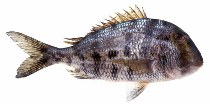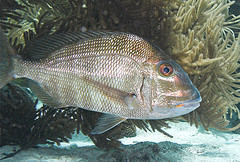Discover Florida Nature
It's time to explore the natural Florida


|
|
|
|
|
 Grass
Porgy (Calamus arctifrons) Grass porgy are
found from Louisiana eastward to Eastern Central Florida! Grass porgy
are found in grass beds and around reefs. They are primarily found
inshore in shallow waters. The grass porgy is omnivorous, feeding on
algae and smaller fish. A grass porgy identification is aided by them
having a black spot larger than the pupil directly on the lateral line
just behind the gill flap. It is the smallest of the porgies, but one of
the prettiest. It grows to six or eight inches in length. Its color is
olivaceous, with dark spots, and several dark vertical bars across the
body; many of the scales have pearly spots; there are several yellow
spots along the lateral line; the cheeks are brownish, with yellow
shades; the upper fins are barred or spotted; the lower fins are paler.
The grass porgy, sometimes called the grass bream or shad porgy,
averages around 1 pound and seldom grows larger than that. Grass
Porgy (Calamus arctifrons) Grass porgy are
found from Louisiana eastward to Eastern Central Florida! Grass porgy
are found in grass beds and around reefs. They are primarily found
inshore in shallow waters. The grass porgy is omnivorous, feeding on
algae and smaller fish. A grass porgy identification is aided by them
having a black spot larger than the pupil directly on the lateral line
just behind the gill flap. It is the smallest of the porgies, but one of
the prettiest. It grows to six or eight inches in length. Its color is
olivaceous, with dark spots, and several dark vertical bars across the
body; many of the scales have pearly spots; there are several yellow
spots along the lateral line; the cheeks are brownish, with yellow
shades; the upper fins are barred or spotted; the lower fins are paler.
The grass porgy, sometimes called the grass bream or shad porgy,
averages around 1 pound and seldom grows larger than that. Jolthead
Porgy
(Calamus bajonado) This is the largest and most abundant
of the porgies. Jolthead Porgy have a range in the Atlantic Ocean from
South Carolina all the way to Brazil including the Bahamas and the Gulf
of Mexico, including both coasts of Florida. The jolt-head is abundant
along the Florida Keys, especially in the vicinity of Key West, where it
is one of the commonest market fishes. The jolt-head resorts to the
rocks and reefs, as well as to hard, sandy shoals, feeding on small
fishes, crustaceans, and soft-shelled mollusks. It grows usually to
eight or ten inches, but often to two feet in length, and six or eight
pounds in weight. The Jolthead Porgy is a large and wide-ranging species
that feeds on sea urchins, crabs, and mollusks. Jolthead Porgy It has a
short, deep body, compressed, its depth being half its length; its back
is more regularly arched than in the other porgies, or not so
humpbacked. The head is large, with a long, pointed snout, and mouth
moderate in size; the profile is more regularly curved than in the other
porgies. The only real markings on the jolthead porgy is a short blue
line under each eye. The corner of mouth and isthmus have slight orange
cast, and this porgy has molar like teeth for urchins, crabs, and
mollusks. Jolthead Porgy inhabit sand as well as coral bottoms usually
in water depths of 20 to 150 feet deep. It spawns in the summer. It is
very voracious, taking almost any kind of bait greedily. It is caught in
company with the grunts and snappers. Jolthead
Porgy
(Calamus bajonado) This is the largest and most abundant
of the porgies. Jolthead Porgy have a range in the Atlantic Ocean from
South Carolina all the way to Brazil including the Bahamas and the Gulf
of Mexico, including both coasts of Florida. The jolt-head is abundant
along the Florida Keys, especially in the vicinity of Key West, where it
is one of the commonest market fishes. The jolt-head resorts to the
rocks and reefs, as well as to hard, sandy shoals, feeding on small
fishes, crustaceans, and soft-shelled mollusks. It grows usually to
eight or ten inches, but often to two feet in length, and six or eight
pounds in weight. The Jolthead Porgy is a large and wide-ranging species
that feeds on sea urchins, crabs, and mollusks. Jolthead Porgy It has a
short, deep body, compressed, its depth being half its length; its back
is more regularly arched than in the other porgies, or not so
humpbacked. The head is large, with a long, pointed snout, and mouth
moderate in size; the profile is more regularly curved than in the other
porgies. The only real markings on the jolthead porgy is a short blue
line under each eye. The corner of mouth and isthmus have slight orange
cast, and this porgy has molar like teeth for urchins, crabs, and
mollusks. Jolthead Porgy inhabit sand as well as coral bottoms usually
in water depths of 20 to 150 feet deep. It spawns in the summer. It is
very voracious, taking almost any kind of bait greedily. It is caught in
company with the grunts and snappers.  Knobbed
Porgy (Istiophorus platypterus) The knobbed porgy is a
beautifully colored, deep-bodied sparid that has a conspicuously steep
forehead and bony protrusions just in front of the eyes. The body is
iridescent silvery blue, and the head is purplish with numerous
yellow-bronze spots and blue streaks under the eyes. The species
inhabits hard-bottom areas-coral reefs, rock outcroppings, and
wrecks-in waters 90 to 300 feet deep from North Carolina to the Florida
Keys and throughout much of the Gulf of Mexico. Because they have large
incisors and strong molars, Knobbed Porgy are able to crush and consume
hard-bodied animals such as clams, snails, crabs, sea urchins, starfish,
and barnacles. They are fast enough to capture small fishes, but these
appear less frequently than invertebrates in the diet. Knobbed porgy are
generally caught with other reef species such as red porgy, whitebone
porgy, white grunt, gag, scamp, and red grouper along the southeastern
United States. Spawning occurs at sea in May and June. Sexual maturity
is reached at age 4 or 5, and the females lay thousands of pelagic eggs.
The species is long-lived and slow growing, reaching a maximum size of
about 20 inches and having a life span of about 17 years. Because they
have large incisors and strong molars, Knobbed Porgy are able to crush
and consume hard-bodied animals such as clams, snails, crabs, sea
urchins, starfish, and barnacles. They are fast enough to capture small
fishes, but these appear less frequently than invertebrates in the diet.
They are fast enough to catch small fish, but fishes are rarely a part
of their diet. Knobbed
Porgy (Istiophorus platypterus) The knobbed porgy is a
beautifully colored, deep-bodied sparid that has a conspicuously steep
forehead and bony protrusions just in front of the eyes. The body is
iridescent silvery blue, and the head is purplish with numerous
yellow-bronze spots and blue streaks under the eyes. The species
inhabits hard-bottom areas-coral reefs, rock outcroppings, and
wrecks-in waters 90 to 300 feet deep from North Carolina to the Florida
Keys and throughout much of the Gulf of Mexico. Because they have large
incisors and strong molars, Knobbed Porgy are able to crush and consume
hard-bodied animals such as clams, snails, crabs, sea urchins, starfish,
and barnacles. They are fast enough to capture small fishes, but these
appear less frequently than invertebrates in the diet. Knobbed porgy are
generally caught with other reef species such as red porgy, whitebone
porgy, white grunt, gag, scamp, and red grouper along the southeastern
United States. Spawning occurs at sea in May and June. Sexual maturity
is reached at age 4 or 5, and the females lay thousands of pelagic eggs.
The species is long-lived and slow growing, reaching a maximum size of
about 20 inches and having a life span of about 17 years. Because they
have large incisors and strong molars, Knobbed Porgy are able to crush
and consume hard-bodied animals such as clams, snails, crabs, sea
urchins, starfish, and barnacles. They are fast enough to capture small
fishes, but these appear less frequently than invertebrates in the diet.
They are fast enough to catch small fish, but fishes are rarely a part
of their diet.
 Littlehead
Porgy (Tetrapterus albidus) The porgies of Florida
belong to the family Sparidae. They are characterized by a
deep, compressed body, humpbacked, with a large head and deep snout, and
with a knob in front of the eye. The mouth is small, with strong, canine
like teeth and molars. This species was first described by Jordan and
Gilbert, in 1883, from Key West. They named it proridens, meaning
"prow tooth," owing to its projecting canines. It is abundant in the
West Indies, and is quite common about Key West and the neighboring
keys. It is brighter in color than the other porgies, being quite
silvery with iridescent reflections; the scales of the upper part of the
body have violet spots, forming longitudinal streaks; those on the lower
part have pale orange spots; the sides have several dark bands; the
snout and cheeks have horizontal, wavy stripes of violet-blue; the
dorsal fin is violet, with orange border; the anal fin is blue; the
caudal fin has an orange band. It is of similar habits to the other
porgies, and found with them, but is less common. It is a good panfish,
growing only to six or eight inches in length. The little-head porgy,
though small in size, is equally as voracious as the other porgies, and
is well worth catching if only to admire its beauty. Littlehead
Porgy (Tetrapterus albidus) The porgies of Florida
belong to the family Sparidae. They are characterized by a
deep, compressed body, humpbacked, with a large head and deep snout, and
with a knob in front of the eye. The mouth is small, with strong, canine
like teeth and molars. This species was first described by Jordan and
Gilbert, in 1883, from Key West. They named it proridens, meaning
"prow tooth," owing to its projecting canines. It is abundant in the
West Indies, and is quite common about Key West and the neighboring
keys. It is brighter in color than the other porgies, being quite
silvery with iridescent reflections; the scales of the upper part of the
body have violet spots, forming longitudinal streaks; those on the lower
part have pale orange spots; the sides have several dark bands; the
snout and cheeks have horizontal, wavy stripes of violet-blue; the
dorsal fin is violet, with orange border; the anal fin is blue; the
caudal fin has an orange band. It is of similar habits to the other
porgies, and found with them, but is less common. It is a good panfish,
growing only to six or eight inches in length. The little-head porgy,
though small in size, is equally as voracious as the other porgies, and
is well worth catching if only to admire its beauty. |
|
|
Advertise | Privacy Statement | Dog Encyclopedia | Video |Contact | Alaska Nature |
|